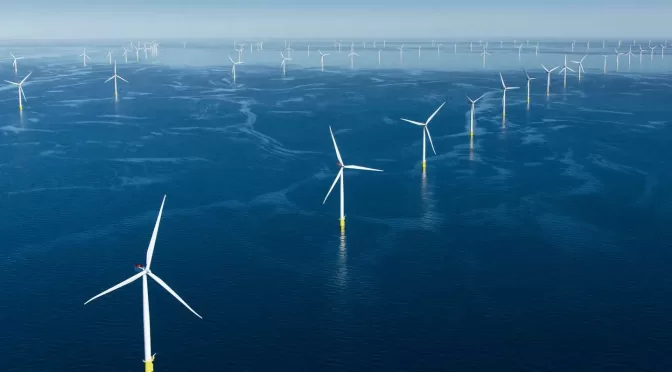UK company National Grid has revealed it is in talks with two other parties about building an “energy island” in the North Sea that would use wind farms to supply clean electricity to millions of homes in north-west Europe.
The idea of a renewable energy hub in the North Sea has been floated for years, but has yet to progress from studies to reality. The concept envisages offshore wind farms that have a much larger capacity than those in use today, with sub-sea electricity cables taking the energy to whichever country needs it most.
National Grid is a major developer of such long-distance cables in the region, most recently one from Norway to the UK, so its involvement in talks with other energy firms increases the chance of the idea being developed.
“We are in tripartite discussions over an energy island that the UK would likely connect to,” says Nicola Medalova at National Grid. She wouldn’t name the two other parties the company is talking to. A spokesperson for National Grid also declined to confirm the parties involved.
“There are now a number of energy island concepts being promoted by different parties in countries such as in Denmark, Belgium and the Netherlands, and we’re in conversations with them all to understand the concepts out there,” said the spokesperson.
Other energy network operators around the North Sea have signalled their interest in building an energy island, including Elia in Belgium and TenneT in the Netherlands.
Two years ago, TenneT concluded that such a project would be technically feasible, despite the engineering challenges. However, the company tells New Scientist that it isn’t in “concrete” talks with National Grid about an energy island. Belgium’s energy minister, Tinne Van der Straeten, said in May that the country would build an island to “interconnect our wind turbines”, built by Elia.
A spokesperson for Elia says it is developing a second electricity interconnector cable between the UK and Belgium, known as Nautilus, but “whether Nautilus will be connected to the Belgian energy island is currently uncertain.”
Denmark has also shown a strong interest in building an energy island, with the Danish government saying in February that it would help finance a £24 billion island to the west of the country. The Danish vision sees a key role for wind power to also generate “green hydrogen”, as the country looks to new exports following a ban on new oil and gas fields.
Medalova says energy islands could either be built on an existing natural island or a purpose-made artificial one. “You put lots of different technologies, perhaps in one space – you could have wind, hydrogen, battery storage, all the rest of it, and that can be connected to one country, two countries,” she says. She adds the project being discussed is looking at “three connection points”, an indication that three countries are involved.
Kees van der Leun of Netherlands-based consultancy Common Futures says: “Connection via an energy hub between the UK and the Netherlands and Belgium, or the Netherlands and Denmark, would certainly add value. This is because of the massive build-out of offshore wind in the UK, and the time difference in wind peaks between the UK and the continent.”
Whichever countries the island is connected to, they could all take advantage of the low-carbon energy generated by hundreds or even thousands of turbines. The energy island could be built before 2030, says Medalova, which would give a huge boost to the promise that UK prime minister Boris Johnson made this week of an entirely green national electricity grid by 2035.
Possible locations for the island haven’t been disclosed. However, TenneT has previously talked about using the shallows of Dogger Bank, a sandbank off England’s north-east coast and a remnant of when the UK and continental Europe were one land mass.
Regardless of whether an energy island materialises, National Grid expects that most new electricity interconnectors it builds will be “hybrid” ones that link two countries but also connect to offshore wind farms in between. The world’s first hybrid interconnector was inaugurated last year, connecting offshore wind farms to Denmark and Germany.
Medalova says this summer the UK government has been encouraging wind farm developers and interconnector companies to work together on such projects to reduce the impact on people living on the coast from new offshore wind farms, which generally require individual connections.
“My gut feeling tells me that all our new interconnectors will be hybrid,” says Medalova. “The way that politics is moving, the way that expectations of coastal communities is moving, the way that the market is moving, there is such a huge expectation we will take this collaborative, sharing approach.”
Read more: https://www.newscientist.com/article/2293043-uk-national-grid-in-talks-to-build-an-energy-island-in-the-north-sea/#ixzz78hfxO0Ws


